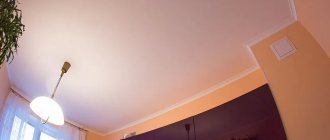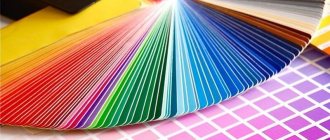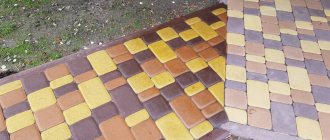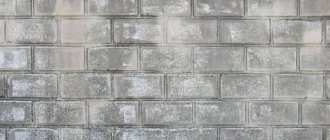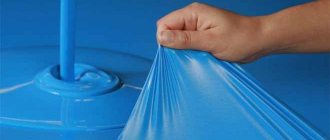Not everyone knows what Venetian paint is, but every person has made renovations to their home at least once in their life. For some it becomes a habit. People see no obstacles to frequently making minor repairs or spontaneously deciding to make a major interior change. Some people make repairs out of necessity, others do it for originality and to demonstrate their wealth. One way to do this is the Venetian. Today, painting walls in this way is very popular and in demand.
For information
One of the most important things in renovation is wall decoration. Just a few decades ago, people could not even think that something special could be done with the walls in their house. The most common method of repair was whitewashing (painting) or wallpapering the walls and ceiling.
Decorative putty has been widely used for quite some time. Wall painting is still used, only with the use of new technologies.
There are several types of wallpaper that are designed separately for the kitchen, bedroom, and there are special types of ceiling coverings. The advantage of decorative putty over wallpaper is that it can be used in different rooms.
Time does not stand still. Every year, new possibilities are invented in construction, which allow not only to create comfort and beauty, but also to stand out from the background of primitive solutions, expanding their capabilities.
A recent invention in the construction industry is decorative plaster. Recently, it has become very popular and has almost replaced primitive wallpaper. Unlike walls covered with wallpaper, decorative plaster makes it possible to convey a variety of colors, play of colors and original ideas. Hypoallergenic building materials that are safe for health are used. They are practical and durable.
This putty is ideal for any room, as it is durable, original and multifunctional.
Main properties and characteristics
Thanks to its ability to “breathe” and its environmentally friendly components, Venetian plaster preserves the microclimate of the room and is harmless to people. A binder material is added to the heterogeneous mass of Venetian plaster to ensure good adhesion. The absence of shrinkage ensures that cracks will not appear on the wall surface over time. Neither water nor sun rays can damage the coating. It is easy to care for.
One of the properties of Venetian plaster, its transparency, makes careful treatment of the walls especially important. They must be perfectly smooth. Wood, brick or concrete are suitable as a base, the main thing is their high-quality preparation.
The color scheme can be any; it is limited only by the preferences of the owner of the room.
Venetian wall painting
The coating, which was used by architects to decorate palaces and temples in ancient times, is called Venetian. This is a type of decorative plaster. This kind of wall covering was considered expensive, and only wealthy people could afford it. The masters did not reveal their skills to a wide range of people, but passed on their knowledge from generation to generation.
Venetian stain is a marble imitation that is used for walls and fireplaces. Today, Venetian plaster is available to a wide range of people. The color range makes it possible to choose a shade for any interior. You can choose between matte and glossy finish. There are 2 types of Venetian - external and internal.
This method of wall decoration gives the room sophistication and uniqueness. In order for the Venetian to look beautiful on the walls, it must be applied correctly. This requires experience and knowledge. Craftsmen who know exactly the intricacies of working with Venetian plaster charge a considerable amount of money for painting work, while the materials themselves are not cheap.
The interior decoration with Venetian plaster looks very beautiful on the walls and fits perfectly into any interior. The technology is already used all over the world. It not only adds originality to wall decoration, but is also a stylish solution for renovation.
Pros:
- Venetian plaster is an environmentally friendly product. During operation and operation it does not pose a threat to health.
- Walls covered with Venetian plaster will delight the eye for many years.
- This coating can minimize visual defects and cracks on the walls.
- Increased moisture resistance.
- Easy to clean.
- You can easily restore or change the color scheme.
- The guarantee for Venetian plaster on walls is up to 10 years.
- Elegance and sophistication, reliability and durability.
Minuses:
- High cost of materials and work of craftsmen.
- Long and thorough preparation of walls for applying Venetian paint. Behind the simplicity of application lies insidiousness: you need to correctly create the surface relief.
Venetian plaster contains marble, quartz and granite dust.
Styles:
- Retro. Craquelure imitates cracks on the walls, which imitates antiquity. This effect is achieved by applying a special varnish to the surface. a unique style is created.
- Marble. Play of shades on the surface. This is a very painstaking job that requires attention, since different shades are applied to the wall about 10 times.
- Marseille wax. Ordinary plaster with the addition of wax. It is distinguished by its water resistance.
What is Venetian and what is its composition?
When talking about Venetian plaster, two concepts are meant at once:
- A special decorative technology for finishing walls, ceilings, columns and other surfaces in the interior. As a result of this finishing, the effect of a marble surface is created. In more rare cases, they imitate other natural stones, such as granite or quartz. This finish completely imitates the glow and reflections, which creates natural marble. This effect can be achieved by applying multiple layers, each of which is sanded and polished.
- The solution itself, which is used to imitate marble. This can be the name of all plasters that create a coating similar to natural marble.
Venetian decorative plaster has a specific composition that determines its properties. The composition must contain marble chips, flour or powder. Cheaper analogues use crumbs of granite, quartz or other mineral (in this case the marble effect will not be achieved). It also contains slaked lime, which acts as a binder, and natural dyes. There are many different versions of Venetian women in the world with a similar composition. The classic version was described above. But you need to understand that in cheap analogues the composition will look like this:
- Artificial fine filler;
- Acrylic and similar synthetic materials (used as a binder);
- Synthetic dyes.
Do-it-yourself Venetian plaster application
Venetian plaster can be purchased at almost any hardware store. Today it is popular among consumers. There are narrow-profile stores where all kinds of colors are presented.
If a choice has been made and the necessary material has been purchased, you can begin to work. For this difficult task you will need practice in working with plaster. It is not a fact that you will get a work of art the first time. But it is important to take into account that before working with difficult material, you need to at least watch video tutorials on how to do it, or be present when a master works. It is also important to adhere to the time scale (drying time for each layer).
As for the tools, you will need rollers, brushes, brushes, spatulas, a Venetian trowel, sponges, paper, stencils, fabric, sandpaper and sanded bars. Quite a considerable arsenal, but if you have to do repairs on your own more than once, then all this will definitely come in handy. Also, in the process of work, some masters experiment, resulting in an original design. You can create additional effects, such as veining or shine.
Before starting work, you need to decide what type of plaster to use - acrylic or lime. You should pay special attention to the quality of the mixture and its texture, and also buy only paint tested by professionals.
The walls must be prepared in advance; they must be perfectly smooth, without flaws. It is necessary to remove the remnants of old wallpaper or previous coating. In order for the work with putty to be of high quality and not problematic, and for the painting to last for many years, you need to remove dust and dirt from the surface and prime the walls.
Venetian plaster is applied in several passes. Each color must dry for the next coat to adhere well. Afterwards the wall is polished. The next stage is waxing. This process takes quite a long time.
Latex paint coating technology
To achieve the result, a special application technique is used. It is also necessary to accurately select the ratio of dark and light colors. For the finishing touch, you can take silver or gold paint and use it to make the surface of the walls in relief, creating unique patterns using a crumpled plastic bag.
Tools and materials
To prepare a perfectly flat surface and obtain the required result (painting an interior wall or ceiling), you will need the following tools:
- spatulas of various sizes;
- foam roller or plastic bag;
- trowel;
- sponge for drawing;
- rags for removing paint drips;
- containers for water and mixtures;
- construction mixer;
- a large bucket of water;
- natural sea sponge (not synthetic);
- colored water-based paint of various shades;
- paint tray;
- old cellophane to cover the floor from paint;
- masking tape;
- brush.
Preparatory work
Paint is demanding on surface quality. If the walls are not put in order, then all the irregularities and flaws under the finishing will be clearly visible. Therefore, you can’t skip the preparatory stage:
- Clean the wall from the old finishing coating - wallpaper, paint.
- Tap the surface to see if the plaster holds well.
- If you find voids under the plaster, remove it. If the areas are large, then the wall will have to be “stripped” down to the brick and re-plastered.
- If the wall is more or less in normal condition, errors in the form of cracks, cavities, and protrusions must be eliminated.
- Remove the bumps using a hammer and chisel.
- Fill all holes and cracks with putty.
- Check the surface with a level. Differences of no more than 1 cm per meter are allowed. Otherwise, you will have to carry out finishing plastering.
- If everything is in order with the evenness of the wall, clean the surface with fine sandpaper, then remove dust. The surface should be smooth to the touch.
- Prime the wall with a deep penetration compound.
- After drying, start painting.
Application technology
The order of work is simple, but it must not be violated. Prepare all the tools and materials so that they are at hand, be patient and get started:
- Pour latex paint into two large plastic trays, filling them to the brim.
- Add a light color to one tray and a dark color to the other.
- It is advisable that the dye does not mix with the entire latex mass. On one side of the tray the paint should be noticeably darker than on the other. To achieve the desired shade, add a little more dye.
- Scoop some light mixture onto a plastic spatula.
- Carefully spread the mixture over the wall. Avoid the formation of drips.
- Then put a dark shade of composition on a spatula. The most important thing is to cover the wall with dark and light areas. This will simulate the appearance of Venetian plaster.
- Using a soft sponge, blend the resulting colors on the wall in a chaotic manner.
Be sure to use a plastic spatula to apply paint. Metal can damage the wall surface.
Gold/silver decoration
After the walls have dried, you can begin applying patterns. Pour some silver or gold paint into the tray (the choice depends on the basic tone of the surface). Crumple the plastic bag and dip it in the mixture. Now start decorating the surface. Chaotically but carefully apply golden blots to the wall. To organize your work, make preliminary markings. Once the paint on the bag is dry, take a soft brush and lightly blend the spots. At the same time, their discontinuous structure should be preserved.
Instead of a bag, you can use a porous sponge. The pattern and its structure will be different.
General information
The latest invention in the field of construction is decorative plaster. In recent years, it has increasingly replaced wallpaper. Using this decoration you can add originality to your walls.
Note: Only materials that are harmless to humans and the environment are used for decoration.
This finish is universal and can be used for absolutely any room.
A little history
In ancient temples and palaces, this technique was used when painting walls, represented by decorative plaster. Such painting was considered a rather expensive pleasure that only people with good incomes could afford. The masters did not share secrets; knowledge was passed down through generations, from father to son.
In essence, Venetian paint was an imitation of marble. Today this type of finishing is gaining increasing popularity. Thanks to a wide palette of shades, it can be used for absolutely any interior. The coating can be made either matte or glossy.
There are two types of Venetian - for outdoor use and for interior decoration.
Decorative paint can be used to recreate the effects of silk, wood, stone, etc. on the wall.
Note: They differ from ordinary ones in that they are environmentally friendly, versatile and aesthetic.
The most optimal type of finishing is the effect of plaster, thanks to which you can hide unevenness. The most common iridescent paint, as well as a chameleon color that shimmers from different sides.
The advantages of the Venetian include safety, durability, and moisture resistance. The surface is easy to clean and can be restored by changing the color. Manufacturers provide a 10-year warranty.
This is interesting: Interior decoration of a house made of laminated veneer lumber
Preparation of working tools and solution
Any master needs a working tool, otherwise his skills will be useless. What can we say about a non-professional who decided to make the apartment beautiful with his own hands. When working with Venetian decorative plaster, you need to know what tools to use. It is necessary to purchase the following tools and accessories in advance:
- Venetian trowel;
- spatula (possibly more than one);
- fur roller with bath;
- construction mixer or electric drill with a “mixer” attachment;
- container for solution;
- sponge;
- polishing machine.
Some of these devices and tools are needed to apply the solution, another part will be needed for finishing, and the third is needed to create the solution. No amount of skills and abilities will save you from failure if you prepare the Venetian plaster solution incorrectly. The process itself is very simple, because the material is sold ready for application in the form of a white thick paste. Therefore, there is only one task - tinting.
You can tint in a bucket with a solution, or you can pour the decorative plaster into a larger container. The second option is more desirable, because you will need to work with a mixer, and there may be splashes. For this reason, a packing bucket may not be suitable. In any case, you will need to add the selected toner in full to the solution. After this, everything is mixed with a mixer until a uniform color is obtained.
You can try to create a Venetian yourself. To do this, you will need to mix marble dust, slaked lime, dyes and water. However, you need to know the proportions, but they are difficult to guess. You will have to experiment a lot to get the desired result. So most people prefer to buy ready-made Venetian decorative plaster.
Details. Application technology
Preparatory work
Before choosing a technique, what color will be applied, you need to bring the surface into the appropriate form. The old coating is removed. It is imperative to check the reliability of the plaster, to see if there are any places where it comes away from the wall. If there is, then such places need to be re-plastered. Make sure that the surface is free of errors, cracks, and protrusions. All this needs to be eliminated.
Afterwards, the surface must be sanded with fine-grained sandpaper, then the remaining dust must be removed. The wall is primed using a deeply penetrating composition. As soon as the primer has dried, begin painting.
You will need for work:
Foam roller; Master OK; Foam sponge for drawing; Rags for removing smudges; Containers for liquid materials Bucket of water; water-based paint of different colors; An old plastic bag to cover the floor.
Glossing, waxing and sanding
An important stage of work in the process of creating the marble effect is glossing, or as it is also called ironing. This method is required to add shine to the surface. You need to work with a trowel on a completely dry surface. The essence of the method is to carry a trowel along the wall at an angle and with a certain pressure, as if you are trying to rip off all the protrusions. Often this glossing is performed after applying each layer, although sometimes this procedure is left only at the end due to the complexity of its implementation.
The Venetian trowel must be clean for glossing, however, as during other work. However, if during ironing, debris (grains of sand) gets under the trowel, this will leave scratches on the entire wall. A similar requirement applies to applying wax.
The last layer is also sanded. The very last layer of decorative plaster is sanded using fine sandpaper. This is done in order to create a smooth color transition over the entire surface and hide the boundaries of its transition. This method also makes the coating perfectly smooth. Venetian decorative plaster may lose its color and gloss after sanding, but we will return it.
Working with sandpaper will create a lot of dust. Although it does not fly very far, you will still need to cover all clean surfaces in the room with film. Also, after thoroughly sanding, you need to walk over the treated surface with a damp cloth so that no dust remains on it. The presence of small crumbs on the wall will not allow you to properly cover it with wax.
They are coated with wax for greater moisture resistance and to give the coating a glossy finish. It can be applied either with a sponge or with a trowel (it must be applied to the skin). If it is necessary to give the coating an additional decorative effect, then special powder is added to the wax. Immediately after application, without waiting for it to dry, the wax is polished to a glossy finish. A grinding machine is used for these purposes. If the wax layer was too large, then the glossy effect will not work. That’s why they prefer to apply it with a trowel, because then the layer always comes out thin.
Application technology
Any construction process is described literally step by step. Finishing with Venetian decorative plaster is no exception; this work must be carried out strictly according to the developed technology. The whole process is divided into several stages. First of all, you should prepare the tools for work and purchase the required amount of materials.
The total amount of plaster mixture is calculated quite simply. You can do the calculation yourself. It is necessary to determine the square footage of the surface of the house to be finished. Find out the material consumption per unit area, taking into account the number of layers applied. This value is a reference value; it can be found either from a construction manual or from the manufacturer’s recommendations. By multiplying the resulting numbers, you get the amount of the main product that will be needed for work.
Preparing the walls
Walls for Venetian cladding must be perfectly smooth and even. It is applied with your own hands on a flat base. Proper preparation is an important stage of finishing. This part of the technology will have to be given due attention, since the finishing, after drying, can reveal all the holes, cracks, even the smallest ones. And then the decoration of the interior will not be the design, but the flaws of the walls, the effect of the work will be zero. Surface preparation can be done in any traditional way:
- leveling with plaster mortar or plasterboard sheets;
- putty with starting composition;
- putty with finishing mixture;
- The final polish is applied with a grinding machine or sandpaper.
Each layer of “wet” work must dry thoroughly before the next one is applied. To ensure that the Venetian interior decoration is of high quality. The last preparatory operation will be to treat the surface of the walls of the kitchen, bathroom and other rooms with a special primer or acrylic paint. The color can be used white, transparent, or match the color of the future cladding.
Main process
You can begin applying “marbled” Venetian decorative plaster after the primer has completely dried, strictly following the sequence of work. The tools used are a trowel and a set of spatulas of various widths: metal, rubber. There is a condition - all tools should not have sharp edges, they need to be rounded and polished. The stages of work are as follows:
- the first layer of Venetian is made very thin, continuous, dried, then all bumps and protrusions are carefully cleaned off;
- the second, as well as all subsequent layers, are applied with free movements, trying to move the hand with the spatula in an arc; this is what will help create chaos in the drawing;
- each layer of Venetian must be completely dry before applying the next one and cleaned with your own hands; Venetian plaster is characterized by many layers: from four to fifteen.
It is recommended to dry each layer of Venetian for at least six hours to obtain the best effect when decorating the interior. The holding time is important, especially when finishing the bathroom and kitchen. There is a requirement according to which it is possible to obtain a beautiful wall surface if the shade of each layer is slightly different from the previous one. Contrasting colors are allowed. In addition, a lot depends on the skill of the plasterer. Everyone uses their own methods of alternating short and long strokes, methods of setting accents, for example, with a mother-of-pearl insert. Each master has his own technique for performing repairs.
Wax is used as a finishing coating, which gives the final shine to the surface, enhancing the color of the marble, makes the wall matte or glossy, and also protects against moisture penetration. It is not recommended to use varnish; it can ruin the entire technology. The last step is to polish the finish with soft cloths yourself.




